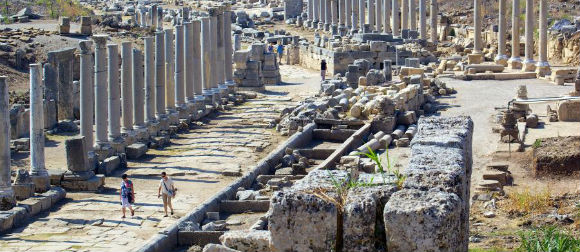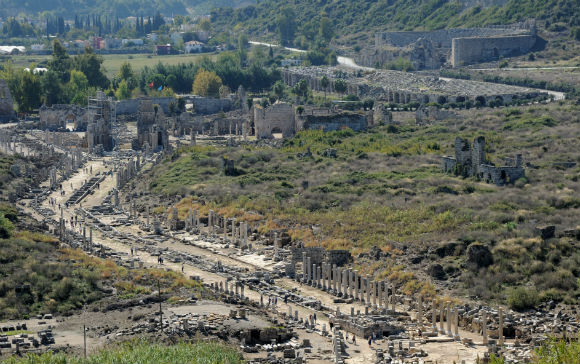The most impressive ruins of the Pamphylian coast are at Perge, at about 15 km east of Antalya. Perge was originally founded by the Hittites around 1500 BC. and was known as Parha. It was a successful trading centre near the Aksu (ancient Kestros or Cestrus) river when Alexander the Great arrived in 333 BC. He was welcomed in by the inhabitants and used Perge as base for his Anatolian campaigns. Alexander was followed by the Seleucids under whom the city prospered and Perge’s most celebrated inhabitant, the mathematician Apollonius from Perge lived and worked. Apollonius was a pupil of Archimedes and wrote a series of eight books on geometry. In 188 BC Perge became part of the Roman Empire during which the city flourished. Most of the surviving buildings date from this period.In 46 AD St. Paul started his journey in Perge (biblical Perga) and preached his first sermon here. Perge gradually declined during the Byzantine period, as the Aksu river silted, but remained inhabited until Selçuk times after which it became abandoned.
A visit to Perge starts by entering the archeological site through the Roman Gate, built during the reign of Septimius Severus (193-211 AD). Proceeding through the gate, to the right is the Agora or market place. This structure of 75 x 75 m dates back from the 2nd century AD. The center courtyard and shops were surrounded by a wide stoa, a covered walkway. The floor of the stoa and shops was made of colored mosaics. The agora was not only the centre of Perge’s trade, but was also a place for meetings as well as a forum for political, social, and philosophical discussions. The next building is the Hellenistic city gate that dates back to the 3rd century BC. This is certainly the most imposing building of the city and was cleverly designed to protect the city with its twin towers and its horseshoe-shaped courtyard at the back. It is thought that the towers had three floors and were crowned by a conical roof. In the year 121 AD, the horseshoe-shaped courtyard was rededesigned as a courtyard of honor. Behind the courtyard stood a triple arch. Around the arch there are about dozen inscriptions connected with Plancia Magna who lived in the 2nd century AD. She was the daughter of the governor, a priestess of Artemis Pergaia (Diana) and a benefactress to the city. Plancia Magna had the arch decorated with the statues of the emperors and their relatives.
After passing through the Hellenistic Gate and courtyard, one enters a broad, marble-paved double-colonnaded street measuring 300 meters in length that extends from the main gate to the acropolis. The street is 20 m wide and is divided in two by a 2 meter wide water channel running down the middle. At the end of the colonnaded street is the Nymphaeum, a triumphal fountain from where a stream flowed down into the water channel. The nymphaeum or nymphaion is an ornamental semicircular structure and dates from the reign of Emperor Hadrian (130-150 AD). A statue of a river god Kestros was located in the center of this huge fountain. Behind the nymphaeum is the acropolis with some remains of the Byzantine period. To the west of the nymphaeum are the remains of a palaestra dating from 50 AD and dedicated to the Emperor Cladius (41-54 AD).
Returning back to the entrance, there are the excavated Roman baths located southwest to the agora. Out of the site proper, is the horsehsoe-shaped stadium, the largest in Asia Minor, measuring 234 m by 34 m. The stadium had a seating capacity of 12,000 people supported by massive barrel-vaulted constructions. Just beyond the site entrance is also the theatre, which is of the Greco-Roman type and could seat 15,000 people. Unfortunately, it is for some time under reconstruction and unfortunately closed to visitors.
Perge,



If you have little time, choose to visit Aspendos rather than Pergé. However, Pergé is interesting as well. Note that the theater in Pergé cannot be visited as it threatens to collapse, which is a bit frustrating.
Less visited than some other ruins, this place is fascinating if you have a guide to explain all.
Very nicely preserved ancient city. It's pretty amazing in that you can still see old shops, and the amphitheatre, and all that jazz.
I also personally like it because it's semi-accessible by public transit, so a cheap trip if you're staying at Kundu Beach. We managed to take a public bus there and walk or hitch-hike a short distance. The…
Very interesting especially if you know Perge from reading about the Apostle Paul who travelled through here and Antalya. Some of the writings have been wonderfully preserved- especially the sign for the Butcher's shop! The Greek and Roman gates are beautiful as are the baths.
The ruins at Perge (English is Perga) were never pillaged and ransacked. An earthquake destroyed the city and remained untouched until Turkish archeologists discovered it. Many of the statuary from the ancient city are in the Perga museum in Antalya, and they are in spectacular shape.
So full of history and beautiful relics it's amazing
As part of an optional tour, with Gate1, we were driven to Perge, to visit this ancient city. The layout is still there. Enjoyed the walkabout as well, its history.
Very big site with lots to see and interesting if you like historical ruins. I would recommend going as part of a tour, as we found the guide very informative and he pointed out things we would otherwise have missed. There are toilet facilities near the entrance.
We visited Perge along with Aspendos and Side on a day tour with Nirvana tours which you can book locally in Antalya or online. The guide was great and it was excellent value for money
Brilliant day out, excellent lesson from our tour guide, enjoyed the ruins a lot. Even my girlfriend who isn't into this at all enjoyed walking around the ruins and learning about it all